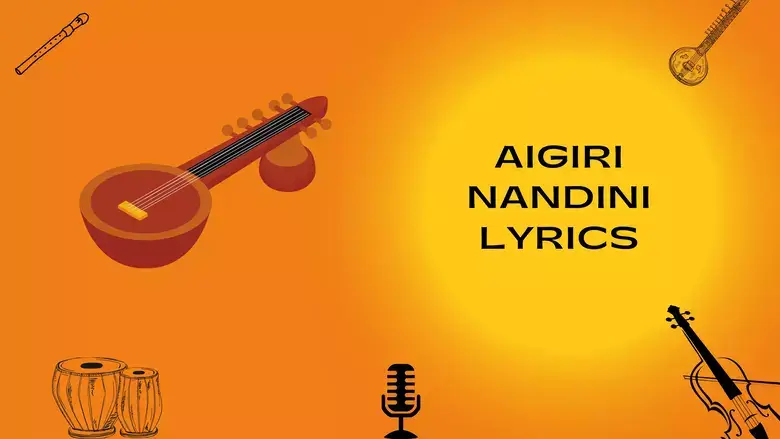When Adharma rises, the all-encompassing mother Shakthi comes to life. She is the heroic warrior goddess who fills her devotees with extreme female energy and wins over the people who try to enslave you with patriarchy! The lyrics of this stotra will enrich you with abundant positivity, rescue you, and guide you toward the path of light.
Let’s get to understand the way to shower her with praise with the powerful sloka, Mahishasura Mardini famously known to us as Aigiri Nandini, that elevates your senses with devotion while lessening her anger toward evil asuras roaming on earth with no regards toward humanity. This blog includes Aigiri Nandini Lyrics in english.
The Legendary Story Of Mahishasura Mardhini (Aigiri Nandini)
The story of Mahishasura begins with his origin. He was born to a demonic couple, Rambha and the buffalo named Mahishi. After intense penance, demon Mahishasuran got a boon of no man defeating him under any circumstance from Agni, the god of fire. The war between the devas led by Lord Indra was futile because of this boon. Assuming that he outsmarted the gods for immortality yet again, he thought himself to be invincible, thinking women as meek beings. The devas decided to turn to Goddess Durga who is also the goddess of mountains. With their chant in the icy mountains, appears Durga who wages a war against the evil demon, Mahishaura. The battle was not an easy win as the asura was powerful in many ways, especially with his shape-shifting capabilities.
Goddess Durga was no ordinary woman either. She was armed by the trishul gifted by Lord Shiva, the Vishnu Chakra from Lord Vishnu, a fierce lion from the mountains who could slay the army into pieces, and a quiver full of arrows that aim right to the enemies’ target given by Vayu, the God of Air. She had menacing eyes, ten arms, and the anger of a thousand suns that scared every demon with her sight.
The war was said to happen for more than a thousand centuries. It is during the last 9 days along with Vijayadasami, she was able to slay the evil demon in full glory celebrated by the entire universe. It is said that she is the mother of her devotees and supposed to nurture all creations without bias. Looking at Mahishasura suffering after she chopped his head, she wanted to end his suffering. She blessed him with happiness by relieving him of his intrusive thoughts of ruling and immortality.
Some scripts say that Aigiri Nandini was formed on Vijayadasami when everyone who witnessed this dreadful war chanted this sloka. It is the story of how Vaishnavadevi took many forms and strategies to kill his army. I’d recommend you to read through this blog to get an entire picture of Aigiri Nandini song history.
The Origin of Aigiri Nandini
Long ago, Adi Shankaracharya was walking in a forest region along with his devoted disciples. Back then paths were formed because of the common routes taken by humans, that are exactly one foot that is enough for one person to go. While journeying through the Manikarnika Ghat that reaches the Ganges where bodies are cremated, the group encounters a grieving woman who was crying about her dead spouse keeping his head on her lap.
Many disciples asked her to clear the way but she was in trance and kept weeping. Intrigued by the situation Adi Shankarcharya himself comes to her and asks her if they can move the body to clear the path to reach their destination. In response, she asks him the reason behind humans doing this act instead of the creator, Brahma. She blames the creator which got Shankaracharya thinking.
He sat there and started meditating to get an answer from Devi. He saw Mahamaya, the goddess of illusion, playing tricks which made Shankaracharya mumble Aigiri Nandini telling the tale of Goddess Durga and how she slayed Mahishasura. This gave the women to move on and gave the way to the group of people.
Since that day, Mahishasura Mardhini or Aigiri Nandini as we know it brings justice and gives strength to the ones who truly take Maa Durga’s refuge.
Aigiri Nandini Lyrics in English
Aigiri nandini nandhitha medhini
Viswa Vinodhini Nandanuthe
Girivara Vindhya Sirodhi Nivasini
Vishnu Vilasini Jishnu Nuthe
Bhagawathi Hey Sithi Kanda Kudumbini
Bhoori Kudumbini Bhoori Kruthe
Jaya Jaya Hey Mahishasura Mardini Ramyaka pardini Shailasuthe (1)
Suravara varshini durdhara Darshini
Durmukhamarshani Harsharathe
Tribhuvana Poshini Sankara Thoshini
Keelbisha Moshini Ghosharathe
Danuja Niroshini Dithisutha Roshini
Durmadha Soshini Sindhusuthe
Jaya Jaya Hey Mahishasura Mardini Ramyaka pardini Shailasuthe (2)
Ayi jagadambha madamba kadam
Bavana Priya Vasini Hasarathe
Shikhari Siromani Thunga Himalaya
Srunga Nijalaya Madhyagathe
Madhu madhure madhu
Kaitabha Banjini Rasarathe
Jaya Jaya Hey Mahishasura Mardini Ramyaka pardini Shailasuthe (3)
Ayi shatha kanda vikanditha runda
Vithunditha Shunda Gajathipathe
Ripu Gaja Ganda Vidhaarana Chanda
Paraakrama Shunda Mrigathipathe
Nija Bhuja Danda Nipaathitha Khanda
Vipaathitha Munda Bhatathipathe
Jaya Jaya Hey Mahishasura Mardini Ramyaka pardini Shailasuthe (4)
Ayi rana durmathashathru vadhothitha
Durdhara Nirjara Shakthi Bruthe
Chathura Vicharadureena Maha Shiva
Dhoothakritha Pramadhipathe
Duritha Dureetha Dhurasaya Durmathi
Dhanava Dhutha Kruthaanthamathe
Jaya Jaya Hey Mahishasura Mardini Ramyaka pardini Shailasuthe (5)
Ayi sharanaagatha vairi vadhuvara
Veera Varabhaya Dhayakare
Tribhuvana Masthaka Shoola Virodhi
Shirodhi Krithamala Shoolakare
Dhumi dhumi Thaamara Dundu binadha Maho
Mukharikruthatigmakare
Jaya Jaya Hey Mahishasura Mardini Ramyaka pardini Shailasuthe (6)
Ayi nija hunkrithi maathra niraakrutha
Dhoomra Vilochana Dhoomra Sathe
Samar Vishoshitha Sonitha Bheeja
Samudhbhava Sonitha Bheejalathe
Shiva Shiva Shumbha Nishumbhamaha Hava
Tarpitha Bhootha Pisacharathe
Jaya Jaya Hey Mahishasura Mardini Ramyaka pardini Shailasuthe (7)
Dhanu ranu shanga ranakshana sanga
Parisphuradanga Natak Katake
Kanaka Pishanga Prishatka Nishanga
Rasadh bhata Shringa Hathavatuke
Kritha Chaturanga Balakshithi ranga
Ghatad Bahuranga Ratad Batuke
Jaya Jaya Hey Mahishasura Mardini Ramyaka pardini Shailasuthe (8)
Suralalanā tatatheyi tatheyi kṛtābhinayodara nṛtyarate
Kṛta kukuthaḥ kukutho gaḍadādikatāla kutūhala gānarate .
Dhudhukuṭa dhukkuṭa dhiṃdhimita dhvani dhīra mṛdaṃga ninādarate
Jaya jaya he mahiṣāsuramardini ramyakapardini śailasute (9)
Jaya Jaya Japya Jaye
Jaya shabdha Parastuti Tathpara Vishwanuthe
Bhana Bhana bhinjimi Bhinkritha Noopura
Sinjitha Mohitha Bhoothapathe
Naditha Nataartha Nadi Nada Nayaka
Naditha Natya Sugaanarathe
Jaya Jaya Hey Mahishasura Mardini Ramyaka pardini Shailasuthe (10)
Ayi Sumanah Sumanah
Sumanah Sumanohara Kanthiyuthe
Sritha Rajanee Rajanee Rajanee
Rajanee karavakra Vrithe
Sunayana Vibhramara bhramara
Bhramara brahmaradhipadhe
Jaya Jaya Hey Mahishasura Mardini Ramyaka pardini Shailasuthe (11)
Sahitha mahaahava mallama thallika
Mallita rallaka Mallarathe
Virichitha vallika Pallika Mallika Billika
Bhillika Varga Vrithe
Sithakritha phulla Samulla Sitharuna
Thallaja Pallava Sallalithe
Jaya Jaya Hey Mahishasura Mardini Ramyaka pardini Shailasuthe (12)
Avirala ganda Galanmadha medhura
Maththa mathangaja Rajapathe
Tribhuvana Bhooshana Bhootha Kalanidhi
Roopa Payonidhi Rajasuthe
Ayi Sudha Theejana Laalasa Maanasa
Mohana Manmatha Rajasuthe
Jaya Jaya Hey Mahishasura Mardini Ramyaka pardini Shailasuthe (13)
Kamala dhalaamala komala kaanthi
Kala Kalithaamala Bala Lathe
Sakala Vilaasa Kalanila yakrama
Keli Chalathkala Hamsa Kule
Alikula Sankula Kuvalaya Mandala
Mauli Miladh Bhakulaalikule
Jaya Jaya Hey Mahishasura Mardini Ramyaka pardini Shailasuthe (14)
Kara murali rava veejitha koojitha
Lajjitha Kokila Manjumathe
Militha Pulinda Manohara Kunchitha
Ranchitha Shaila Nikunjagathe
Nija Guna Bhootha Mahaa Sabari Gana
Sathguna Sambhritha Kelithale
Jaya jaya hey mahishasura mardini ramyaka pardini shailasuthe (15)
Kati thata peetha dukoola vichithra
Mayuka thiraskritha chandra ruche
Pranatha Suraasura Mouli Mani Sphura
Dansula sannakha chandra ruche
Jitha kanakachala maulipadorjitha
Nirbhara kunjara kumbhakuche
Jaya jaya hey mahishasura mardini ramyaka pardini shailasuthe (16)
Vijitha sahasra karaika sahasrakaraika
Sarakaraika nuthe
Krutha Sutha Tharaka Sangaratharaka
Sangaratharaka soonu suthe
Suratha samadhi samana samadhi
Samadhi samadhi sujatharathe
Jaya jaya hey mahishasura mardini ramyaka pardini shailasuthe (17)
Padhakamalam karuna nilaye varivasya
Dhiyonudhi nansha shive
Ayi kamale kamala nilaye kamala nilayahssa
kathamna bhaveth
Thava padameva param Padha Mithyanu
sheelayatho mama kimna shive
Jaya jaya hey mahishasura mardini ramyaka pardini shailasuthe (18)
Kanakala sathkala sindhu jalairanu
Sinjinuthe guna ranga bhuvam
Bhajathi sakimna sachee kucha kumbha
Thati pari rambha sukhanubhavam
Thava charanam saranam kara vani
Nataamaravaani nivasi shivam
Jaya jaya hey mahishasura mardini ramyaka pardini shailasuthe (19)
Thava vimalendu kulam vadhanaedhu
Malam Sakalam nanu kulayathe
Kimu puruhootha purendu mukhi
Sumukhi bhirasow vimukhee kriyathe
Mamathu matham shiva namadhane
Bhavathi kripaya kimuth kriyathe
Jaya jaya hey mahishasura mardini ramyaka pardini shailasuthe (20)
Ayi mayi deena dayalu Dhaya kripayaiva
Tvaya bhavi thavya mume
Ayi jagatho janani kripayaasi yathaasi
Thathaanu mithaasi rathe
Yaduchitha mathra bhavathyu rarikurutha
Durutha pamapaakuruthe
Jaya jaya hey mahishasura mardini ramyaka pardini shailasuthe (21)
For those who want to better comprehend the hymn, Aigiri nandini lyrics in english transliteration provides clarity and allows non-Sanskrit speakers to follow along. It also allows a global audience to understand the significance of the lyrics. Regional languages increase the hymn’s listener reach. Below is the rajalakshmee sanjay aigiri nandini lyrics version.
Aigiri Nandini Lyrics Meaning
Maa Durga – The mountain’s daughter who amounts to rejoice the World
The first verse is Nandin calling out to the daughter of the mountain, who makes the whole earth revolve around happiness and the universe in a euphoric state of mind. The goddess is said to sit on the peak of Vindhya mountain that is said to shine naturally (this also could mean the goddess giving abundant happiness to Lord Vishnu). This verse pays tribute to her victories.
Shakthi is the wife of Neelakanta (Lord Shiva who holds poison between his neck when the ocean made of milk was churned in a mythological story and hence got the name, Neelakanta). She is described as a goddess who protects one’s family shouting out victory in every direction. She is the one who destroyed the diabolic demon, Mahisa, who is adorned with intricate braids and the daughter of the Himalayas.
Maa Durga – Who destructs Danavas and Daityas while nourishing the three worlds
Maa Durga is known to give boons to gods, and the one who destroys the stubborn thinking himself as invincible, that makes him look ugly from the inside. She nurtures all the three worlds – the heaven, the hell and the earth that are referred to as the Three Worlds as per hindu scriptures and mythological stories.
She is the one who pleases her husband at all times, while removing the sins of her devotees and engrossed in the chant of the universe, OM. She is angry while assailing the successors of the demon, Danu and his son, Diti. The daughter of oceans burns their pride into ashes.
Maa Durga – The victorious destroyer of the demons, Madhu and Kaitabha
The poet calls the mother of the world as his own in devotion. He describes her as the ever-smiling goddess, walking inside thick forests filled with Kadamba (a favorite flower of Shakthi). She is always on top of the Himalayas watching over her devotees’ deeds, smelling like the sweetness of honey or nectar. She kills the demons, Madhu and Kaitabha while dancing to victoriously relieve her devotees from their evil spell.
Maa Durga – The destruction of the demons, Chanda and Munda
The poet describes the destruction of the demons by splitting their heads and shredding them to a hundred pieces. She demolishes their army of elephants by breaking their trunks with her skilled lion (her choice of vehicle) that tears them apart apart from her breaking their heads with her bare hands.
Maa Durga – The one who turned Lord Shiva into a messenger to her enemies
The fifth verse is about goddess Shakthi who gives you immense force and infinite energy to vanquish enemies in the battlefield and eliminates all ill intentions. She sends Lord Shiva as a diplomat to Dhanavas and finishes all forms of evil at once. Even in that chaos, she gives the asuras a second chance to become a better being that proves her to be the forever, passionate mother of the universe.
Maa Durga – A giver of forgiveness to those who repent their sins
She accepts any devotee when they repent and fall at their feet. This plight is prevalent to the asuras’ wives in most cases who lost their partners in the battle. She points her trident (trishul) onto the enemies’ heads that forms a ripple effect in all the three worlds (heaven, hell, earth). She dances the Thandava on the battlefield that resonates like a thousand trumpets calling war after making the asuras’ heads into her garland like a medal shining like the blazing sun.
Maa Durga – The destroyer of the demons, Dhumralochana, Raktabija, and Shumbha Nishumbha
When Maa Durga roars in anger, it will demolish all the smoke coming from the bloodshot demons’ noses. These demons had a special boon which creates another form of himself with every drop of his blood touching the earth’s surface. She drinks all the blood while fighting them, despite them emitting poison from their eyes. These demons, Shumba Nishumba, Dhumralochana, and Raktabija were devotees of her husband, Lord Shiva. Though she kills them with her trishul, she chants HIS name to give them salvation and a better after life.
Maa Durga – The destroyer of Chaturanga
She adorns herself with unusual ornaments and it looks like a graceful dance in a bloodshed battlefield. When the demon Chaturanga and his army aimed at Maa Durga with golden and red arrows, she destroyed them with a brown quiver of arrows giving the entire universe a myriad of colours making it look like a Big Bang, the creation with the blast of tiny soldiers screaming in pain.
Maa Durga – If war could look like a cosmic dance
She is the one who takes you on a delightful spell with the damsels of the cosmic world dancing to her moves. Her knotted hair and her laughter while dancing and the feeling of abandonment with the constant chimes of Tha-ka-dhi-mi-tha from a mridanga ( Carnatic percussion instrument ), blesses the ones who seek her refuge. The final line of each verse means the daughter of the mountains wishing her nothing but victory by her devotees to vanquish the Mahisha demon.
Maa Durga – The union of Shakthi and Shiva together as Ardhanari
This is the part of the war where Shakthi becomes Ardhanari, a form of Shiva and Shakthi together in exactly half showcasing equality. Victory is sung across universes with Shiva’s twinkling bells of joy and the goddess dancing while merging into him equally. It was expressing a divine dance-drama in the cosmos.
Maa Durga – The union of beauty and brains
Shakthi’s devotees invoke her presence to save them whose beauty is as charming as her mind. Her beautiful face is described as the lure of the moon lighting the night. Her eyes are said to conquer the beauty of the bees. The daughter of Mountains shines through all difficulties, looking victorious after demolishing Mahishasura.
Maa Durga – Looks can be deceptive to the evil
This verse describes the daughter of mountainous region who gives strength to the Bheel women who resemble a jasmine, and buzz like a swarm of bees, but fight battles with trained wrestlers with a captivating smile that resembles the crimson flowers shining through the sliver of light from dawn with lustrous locks of hair spelling victory. Victory to the one who destroyed Mahishasura with flying colours.
Maa Durga – The origin of skill, charm and power
Shakthi takes charge of the royal elements with fury that their temples had streams of its blood continuously. She is described as the princess and the daughter of the ocean with the beauty of the moon that ornaments all the three worlds. With her charm and the fact that she was the princess of Kama deva, the Hindu mythological equivalent of a cupid, she enchants the minds of her enemies by showing her teeth with a beaming smile.
Maa Durga – The flawless goddess who is as pure as the lotus petal
Maa Durga is described as the flawless goddess with a complexion that is as pure as the lotus petals. Her heart of gold is imprinted with every step she takes with a flock of swans leading her gracefully, accompanied by a swarm of bees that looks like a crown above the lotus symbolising procreation.
Maa Durga – The one whose voice sounds sweeter than a cuckoo and the mesmerising flute
When the all-knowing Shakthi starts to speak, it puts the Cuckoo or Kolia bird’s voice to shame, that sounds like a melodious flute. The colourful mountains she live in has tribal men who are pleasant along with their partners who are the incarnations of Shakthi’s qualities, making an entire tribe flourish forever.
Maa Durga – The radiance of her toe nails worshipped by the Devas and the Asuras
This verse praises goddess Durga’s looks. Even her yellow silk attire shines like the moon with colourful hues that flow from her waist. Her toenails twinkle like the moon that dazzles because of the bespoke jewels that glisten beyond the wild elephants’ temple while she gracefully sits on the peaks of golden mountains, worshipped by all celestial beings, gods, and demons.
Maa Durga – The one who blesses Suratha and Samadhi
During the war, goddess Durga had to face so many demons on her way to finally slay Mahishasuran. She had to deal with Sahasrajuna, a demon who emanates a thousand suns. She helps her son, Karthikeya, to tackle Tarakasura to rescue the devas from his prison made by Maya, the goddess of illusion. She gives the mental agony to King Suratha and gives him worldly gains. She also gives merchant Samadhi, the gift of spiritual knowledge after crushing the demon, Mahishasura, with glorious victory.
Maa Durga – The habitat of Mahalakshmi
In this verse, the poet describes Shakthi’s feet as lotus that metaphorically means compassion. He asks if you pray and fall at her lotus feet, would we as devotees become an abode of the lotus itself that is filled with purity and prosperity like Goddess Lakshmi? Falling at her feet is like a refuge to practice true devotion.
Maa Durga – A habitat of Saraswati devi
This verse is where the devotees invoke Goddess Durga and wash her from the river that ebbs like golden lines. The poet compares the satisfaction like the happiness of Indra that embraces the cosmic heart. They pray to Goddess Saraswathi where auspiciousness fills your space making it an abode of Lord Shiva.
Maa Durga – Pure as the moon with subdued impurities
In this verse, Goddess Durga’s face is compared to the moon with purity that reveres all kinds of impurities. If he had not seen her spotless face, the poet might have turned away from the beautiful womenfolk of Lord Indra’s castle for Shakthi carries the treasure of Lord Shiva within us and it means nothing without HER kindness.
Maa Durga – The one who showers her blessings just like she demolishes her enemies
This is the last verse of the Mahishasura Mardini slokam where the poet asks on behalf of all her devotees to be compassionate to the people with misery just like how she vanquished her enemies with a quiver full of arrows. He requests Uma devi to take care of her bhaktas to remove all their sorrows just like how a mother would protect her children.
Mahishasura Mardhini (Aigiri Nandini) Significance
The main reason behind Mahishasura Mardhini is the origin of the annual festival of Navarathir celebrated in different ways across the country. However, they celebrate the victory of the powerful goddess Durga and her valiant ways of killing the buffalo demon, Mahishasura. You might have heard how each day of Navratri (translated as Nine Days) signifies a different Shakthi. This is because of Durga taking all those forms to bring down the demon’s army at once proving good always triumphs the evil – the boon from any god doesn’t matter.
Meaning of Aigiri Nandini mantra represents all the demons within us including Mahishasura (the inertia of war), Shumbha & Nishumbha representing pride and shame respectively, and Madhu & Kaitabha (extreme forms of craving and aversion). It might sound like opposites but they complement each other simultaneously. The dormant energy brings out our negativities and obsessions (Raktabheejasura). Chanda and Munda represent the demons that cause illogical reasoning. These are the demons within us and only Shakthi can help us. Learn this sloka with passion for it will calm you down and give you the ultimate peace that everyone is looking for!
Conclusion
There are 21 verses in this sloka that get touch to pronounce while keeping the rhythm in place. It is also said to be extremely powerful. Therefore, I’d recommend you to take your time to learn this either from online platforms by slowing down the song.
The key reason for Aigiri Nandini song’s popularity is it’s ability to encourage dedication and positivity. Furthermore, understanding the Aigiri Nandini lyrics meaning and its enhances the spiritual experience.
One of my most favorite versions is the enchanting voice of Rajalakshmee Sanjay with the lyrics that will make it easy for you to learn. Alternatively, you can seek a teacher who knows this sloka at the back of his/her hand along with the right Aigiri Nandini lyrics meaning for to be imprinted in her head like a muscle memory. If you’re looking for a other beautifully written and performed devotional song to add to your collection, we highly recommend other songs such as Alaipayuthey Kanna.
FAQs
What is the meaning of Aigiri Nandini?
The word ‘Ai’ in Sanskrit means the Divine Mother. Giri Nadini translates to the daughter of the Mountains. Therefore, Aigiri Nandini is the people calling out the Daughter of Mountains who is also the mother of the entire universe and creation.
Who composed Aigiri Nandini?
Aigiri Nandini was composed by Shri Adi Shankaracharya, a renowned Guru for many. He composed this as a revelation to a woman’s plight who was grieving for her husband’s demise who blamed Brahma, the creator, for her loss. He understood her predicament and started meditating while the Sanskrit hymn flowed in his mouth with the presence of Mahamaya, the goddess of illusion, in a deep meditative state.
Is Aigiri Nandini a Durga Stotram?
Yes, Aigiri Nandini is a sloka that tells the tale of how goddess Durga slayed the evil demon Mahishasura during a war waged against him. The victory of this war is the Navarathri we celebrate even today. The stotram is called Mahishasura Mardhini referring to Vaishnava Devi, the killer of Mahisha.
Where can I find the lyrics for Aigiri Nandini?
You can find the lyrics of Aigiri Nandini in the above blog. Alternatively, you can learn from lyrical platforms like Gaana Jio Saavn, and Youtube where you can sing along with the sloka while learning the lyrics. The best would be to learn from a teacher in a one-on-one session to understand the true essence of this powerful sloka.
What is the significance of Aigiri Nandini in Hindu mythology?
Chanting Aigiri Nandini is said to calm her devotees, especially the feminine folklore. In Hindu Mythology, it is the tale of Goddess Durga killing Mahishasuran with glory stating good triumphs evil. The chant will destroy one’s fears, and self doubts bringing one’s inner strength to light.
Are there any popular renditions of Aigiri Nandini?
There are many popular renditions of Aigiri Nandini including the remixed version of Brodha V, a rapper who illustrates the difficulties of the women of today in a rock version. One more is the Coke Studio Season 3 version sung by Aruna Sairam and Sona Mohapatra composed by Ram Sampath.
The note-worthy traditional versions include the original chant we know of that plays in temples with the sweet voice of Rajalakshmee Sanjay. Some more versions are Sooryagayathri, Bombay Jayashri, and S. Sowmya.
How to learn to sing Aigiri Nandini?
Some say learning to chant Aigiri Nadini or the Mahishasura Mardhini slokam is an ordeal. I’d say with pure Bhakthi and a good teacher, you can learn to sing it with ease. The ideal process would be to familiarise with the tune, then learn it verse by verse and progress into completion. It is important to enunciate the lyrics properly to bring out its full power to you and your loved ones around you.
What is the structure of Aigiri Nandini?
The basic structure of Aigiri Nandini is pretty straightforward. It comprises 21 verses with each verse containing four lines. Most of the chant versions are a simple melody that repeats for all the verses.
What language is Aigiri Nandini written in?
Aigiri Nandini is a hymn written in Sanskrit, a primal language of India. This sloka is especially difficult, comprising many tongue twisters that are interesting to learn.
Related blog: Achyutam Keshavam Lyrics






























